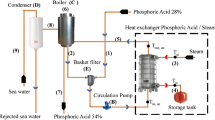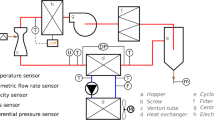Abstract
Crude oil fouling in refinery preheat exchangers is a chronic operational problem that compromises energy recovery in these systems. Progress is hindered by the lack of quantitative knowledge of the dynamic effects of fouling on heat exchanger transfer and pressure drops. In subject of this work is an experimental determination of the thermal fouling resistance in the tubular heat exchanger of the crude oil preheats trains installed in an Algiers refinery. By measuring the inlet and outlet temperatures and mass flows of the two fluids, the overall heat transfer coefficient has been determined. Determining the overall heat transfer coefficient for the heat exchanger with clean and fouled surfaces, the fouling resistance was calculated. The results obtained from the two cells of exchangers studies, showed that the fouling resistance increased with time presented an exponential evolution in agreement with the model suggested by Kern and Seaton, with the existence of fluctuation caused by the instability of the flow rate and the impact between the particles. The bad cleaning of the heat exchangers involved the absence of the induction period and caused consequently, high values of the fouling resistance in a relatively short period of time.














Similar content being viewed by others
Abbreviations
- A:
-
The heat transfer external surface (m2)
- a⊥, ac⊥ :
-
The fluid passage area at side tube and side calender, respectively (m2)
- CP :
-
The heat-storage capacity (kJ/kg °C)
- CPf, Cpc :
-
The heat-storage capacity (kJ/kg °C)
- d:
-
The fluid circulating density at side tube
- di:
-
Tubes interns diameter (m)
- d0,e :
-
Diamètre externe des tubes (m)
- d 154 :
-
Density
- Dc, De :
-
Diamètre de la calandre et diamètre hydraulique, respectivement (m)
- ft :
-
The friction factor
- F:
-
The correction factor
- Gt :
-
The mass speed fluid circulating at side tube (kg/h m2)
- hi :
-
The heat transfer coefficient at internal film (kW/m2 °C)
- h0 :
-
The heat transfer coefficient at external film (kW/m2 °C)
- hi0 :
-
The heat transfer coefficient at internal film brought back to the external surface (kW/m2 °C)
- Jhf, Jhc :
-
Coefficient de transfert pour le fluide froid et chaud, respectivement (kW/m2 °C)
- l:
-
Tubes length (m)
- m:
-
The cold fluid mass flow (the crude oil) (m3/h)
- mf, mc :
-
Débit massique pour le fluide froid et chaud, respectivement (kg/s)
- mf⊥, mc⊥ :
-
Mass flow for the cold and hot fluid, respectively, concerning the straight section (kg/s)
- MLDT:
-
The difference logarithmic temperature (°C)
- nc, nt :
-
The devices and the master keys numbers
- Pe, Ps :
-
Inlet and outlet pressure of the crude oil respectively (Pascal)
- Prf, Prc :
-
The Prandtl number for the cold and hot fluid, respectively
- Qf, Qc :
-
Volume flow for the cold and hot fluids, respectively (m3/s)
- Rd :
-
Fouling resistance (m2 °C/kW)
- Ref, Rec :
-
Reynolds number for the cold and hot fluid, respectively
- te, ts :
-
Inlet and outlet temperatures of the crude oil, respectively (°C)
- Te, Ts :
-
Inlet and outlet temperatures of head ebb respectively (°C)
- Tc :
-
Calorific temperature of the hot fluid (°C)
- tc :
-
Calorific temperature of the cold fluid (°C)
- US, UP :
-
The overall heat transfer coefficient at the dirty state and the clean state, respectively (kW/m2 °C)
- ρf, ρc :
-
Density for the cold and hot fluids, respectively (Kg/m3)
- μf, μc :
-
Dynamic viscosity for the cold and hot fluids, respectively (Kg/m s)
- ϕt, ϕs :
-
The viscosity correction coefficient for the cold and hot fluids, respectively
- δRd :
-
The fouling resistance uncertainty
- δUs :
-
The overall heat transfer coefficient at the dirty state uncertainty
- δUp :
-
The overall heat transfer coefficient at the clean state. The overall heat transfer coefficient at the dirty state and the clean state
- Δpexp, Δpth :
-
The experimental and theoretical pressure drops (Pscal)
References
Gu T, Albert F, Augustin W, Chew YMJ, Mayer M et al (2011) Application of fluid dynamic gauging to annular test apparatuses for studying fouling and cleaning. Exp Therm Fluid Sci 35:509–520
Farajollahi B, Gh Etemad S, Hojjat M (2010) Heat transfer of nanofluids in a shell and tube heat exchanger. Int J Heat Mass Transf 53:12–17
Lalot S, Pálsson H (2010) Detection of fouling in a cross-flow heat exchanger using a neural network based technique. Int J Therm Sci 49:675–679
Pogiatzis T, Ishiyama EM, Paterson WR, Vassiliadis VS, Wilson DI (2011) Identifying optimal cleaning cycles for heat exchangers subject to fouling and ageing. Appl Energy 89:60–67
Mohanty D K, Singru P M (2011) Use of C-factor for monitoring of fouling in a shell and tube heat exchanger. Energy: 1- 6
Bl Yeap, Di Wilson, Gt Polley, Sj Pugh (2004) Mitigation of crude oil refinery heat exchanger fouling through retrofits based on thermo-hydraulic fouling models. Chem Eng Res Des 82:53–71
Radhakrishnan Ramasamy M, Zabiri H, Thanh V, Nm Tahir, Mukhtar H, Mr Hamdi, Ramli N (2007) Heat exchanger fouling model and preventive maintenance scheduling tool. Appl Therm Eng 27:2791–2802
Vessakosol P, Charoensuk J (2010) Numerical analysis of heat transfer and flow field around cross-flow heat exchanger tube with fouling. Appl Therm Eng 30:1170–1178
Srinivasan M (2005) Heat exchanger fouling of some Canadian crude oils. Heat Transf Eng 26:7–14
Asomaning S (2005) Heat exchanger fouling by petroleum asphaltenes. Ph.D. Thesis, University of British Columbia
Saleh Z, Sheikholeslami R, Pwatkinson A (2005) Fouling characteristics of a light Australian crude oil. Heat Transf Eng 26:15–22
Vr Radhakrishman, Ramasamy M (2005) Heat exchanger fouling model and preventive maintenance scheduling tool. Appl Therm Eng 27:2791–2802
Aminiam J, Shahhosseini S (2008) Evaluation of ANN modeling for prediction of crude oil fouling behavior. Appl Therm Eng 28:668–674
Dk Mohanty, Pm Singru (2001) Use of C-factor for monitoring of fouling in a shell and tube heat exchanger. Appl Therm Eng 36:2899–2904
Em Ishiyama, Av Heins, Wr Paterson, Spinelli L, Dl Wilson (2010) Scheduling cleaning in a crude oil preheats train subject to fouling: incorporating desalter control. Appl Therm Eng 30:1852–1862
Wang S, Wen J, Yanzhong L (2009) An experimental investigation of heat transfer enhancement for a shell-and-tube heat exchanger. Appl Therm Eng 29:2433–2438
Sanaye S, Hajabdollahi H (2010) Multi-objective optimization of shell and tube heat exchangers. Appl Therm Eng 30:1937–1945
Taler D (2013) Experimental determination of correlations for average heat transfer coefficients in heat exchangers on both fluid sides. Heat Mass Transf 49:1125–1139
Oufer L, Mouheb A, Kaci O, Boukhelfa F (2000) Fouling of a shell and tube preheat in Refinery plant. International congress of chemistry and production, Praha
Harche R, Absi R, Mouheb A (2014) Study of the fouling deposit in the heat exchangers of Algiers refinery. Int J Ind Chem 5:1–8
Abd Elhady M, Clavers SH, Adriaans TNG, Rindt CCM, Wijers JG, Van Steenhoven AA (2007) Influence of sintering on the growth rate of particulate fouling layers. Int J Heat Mass Transf 50:196–207
Salehi H, Zeinali Heris S, Esfandyari M, Koolivand M (2015) Erratum to: neuro-fuzzy modeling of the convection heat transfer coefficient for the nanofluid. Heat Mass Transf 51:575–583
Author information
Authors and Affiliations
Corresponding author
Rights and permissions
About this article
Cite this article
Harche, R., Mouheb, A. & Absi, R. The fouling in the tubular heat exchanger of Algiers refinery. Heat Mass Transfer 52, 947–956 (2016). https://doi.org/10.1007/s00231-015-1609-0
Received:
Accepted:
Published:
Issue Date:
DOI: https://doi.org/10.1007/s00231-015-1609-0




